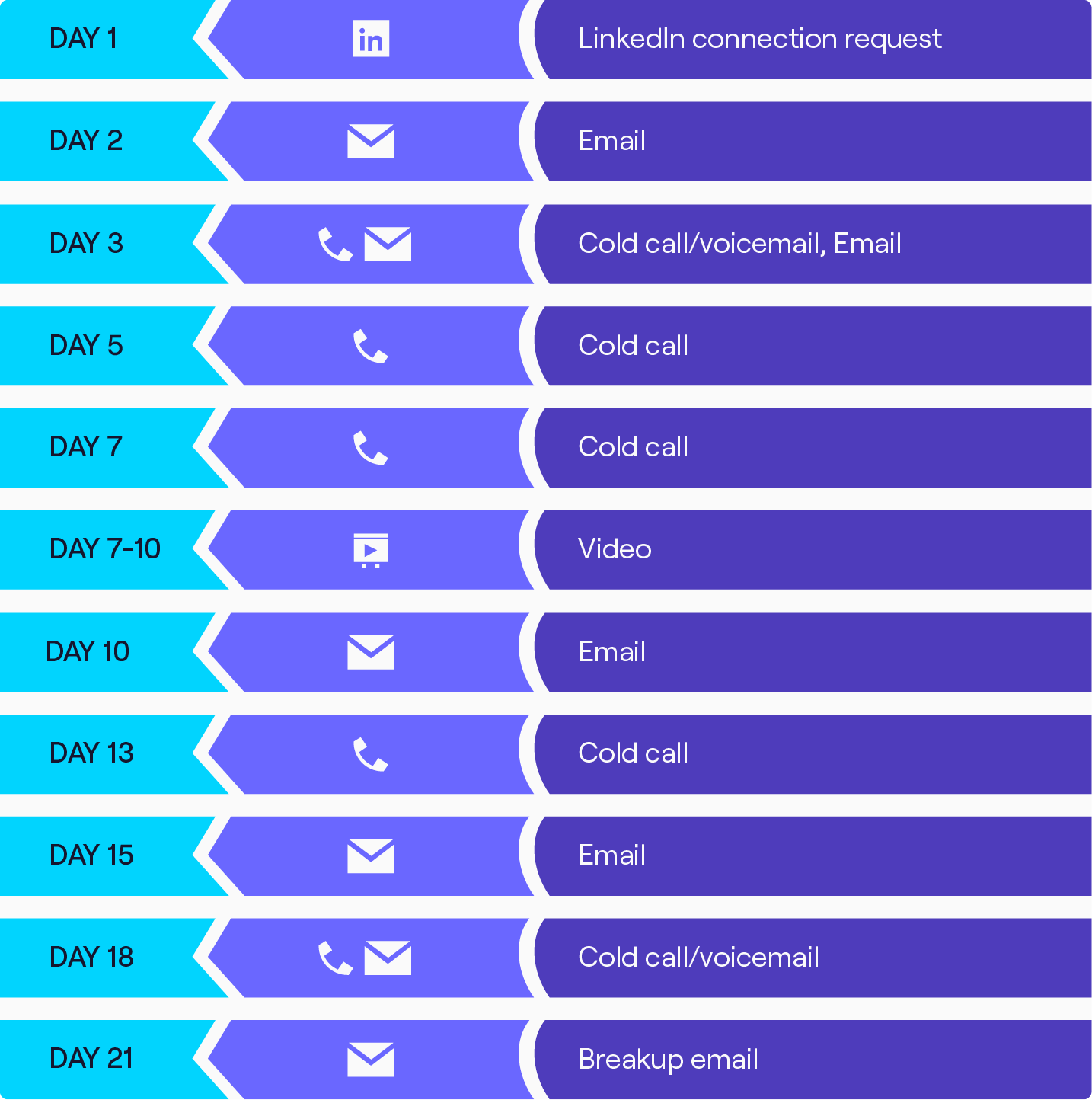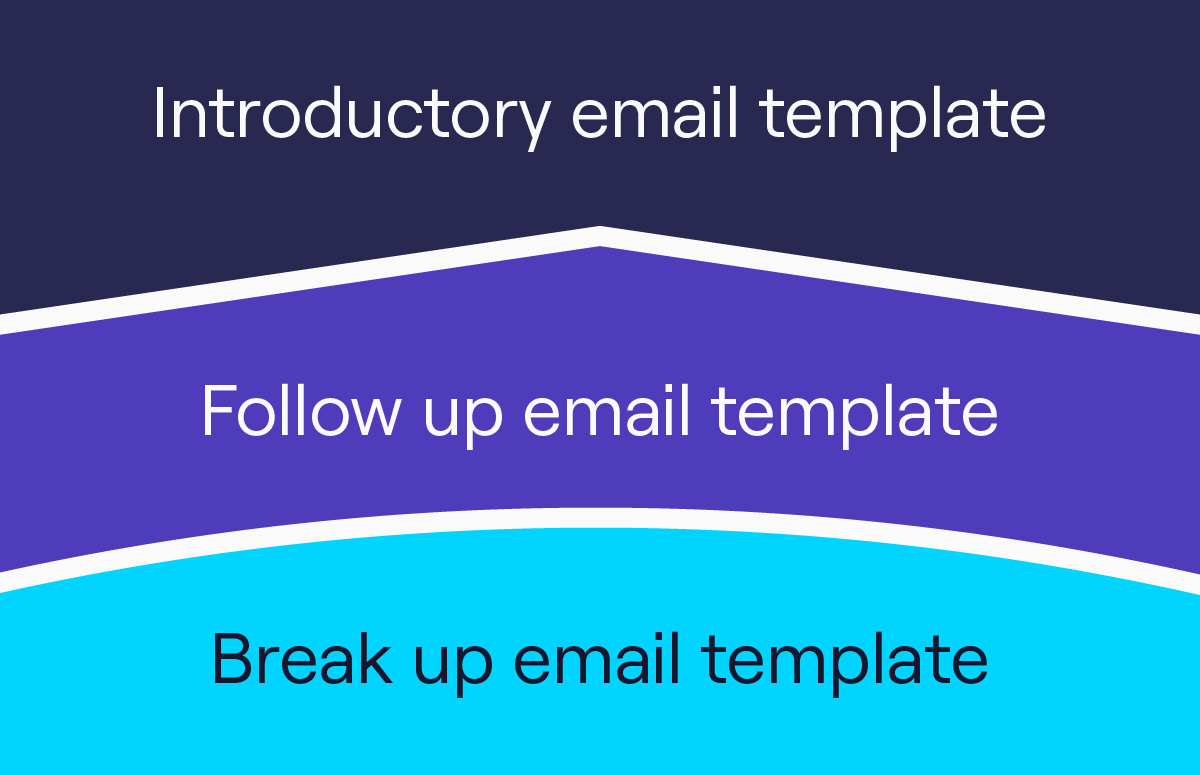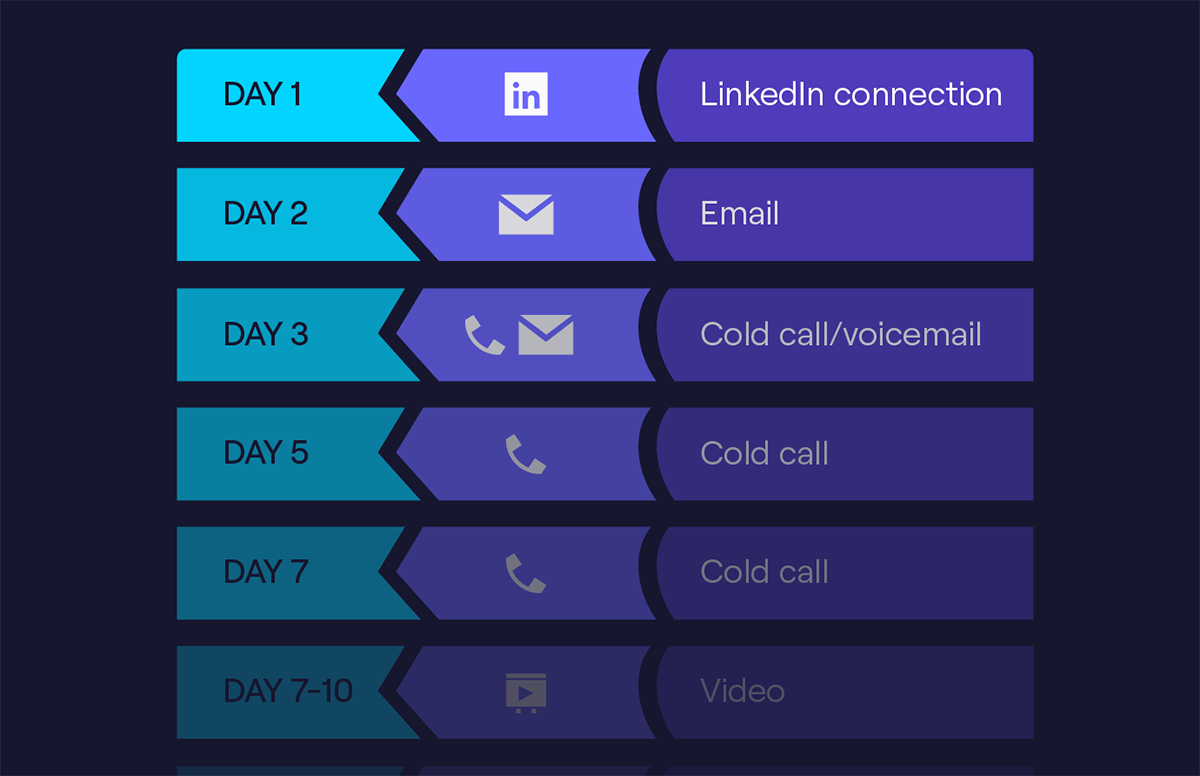How to Build a Sales Cadence: Examples, Tips and Tools
Sales cadences are your secret weapon for turning prospects into customers. When used correctly, they keep your leads engaged, objections conquered, and deals closed.
In this blog, we’re diving headfirst into the art of crafting sales cadences that convert, giving you best practices, examples, tips and more.
What are you waiting for? Go ⬇️
What is a sales cadence?
A sales cadence is a structured sequence of touchpoints/interactions that a salesperson uses to engage with prospects and leads.
It’s a well-planned series of steps designed to move a prospect through the sales process, from initial contact to closing a deal or making a sale.
What’s the difference between a sales cadence and a sales script?
While cadences and scripts are both important in B2B sales, they serve different purposes.
A sales cadence is a strategic framework that contains several multi-channel touchpoints, while a sales script is a specific tool used within the cadence to guide individual conversations.
A salesperson may use several sales scripts within a single cadence to interact with prospects.
Sales cadence best practices
Here are some answers to some frequently-asked cadence questions 👇
What’s the ideal length of a sales cadence?
Morgan J Ingram, Cognism’s Creative Advisor, recommends a 17-21-day sales cadence.
Why?
You have to give the prospect time to get back to you! A 17-21-day cadence allows you the space to build trust and address prospect objections.
How many touchpoints should a cadence contain?
For Florin Tatulea, Director of Sales at Barley, the best sales cadences contain 8-12 touchpoints.
Having fewer touchpoints in a longer cadence means you won’t be bombarding your prospects with requests; the idea is to make your cadence as value-led as possible.
Doing this makes it more likely that your prospects will respond.
Florin told us:
“You should never over-index on one piece of outreach. You need to give people time to see your message and get back to you.”
What are the best channels to use in a sales cadence?
The 4 key channels are the phone, email, LinkedIn and video.
As your cadence progresses, double down on the channels where you get responses.
As Morgan said:
“You don’t know how people are going to reply, so it’s important to use every available channel.”
Should you have different cadences for different territories?
Yes - you should always consider regional differences in outbound sales.
Cognism’s SDRs have observed the following:
- Cold calling is a more popular channel in the US.
- Fewer touchpoints are required in APAC and EMEA.
- Triple touchpoints on Day 1 may seem intrusive in some regions, especially DACH.
How many cadences should your sales team use?
Morgan’s advice is to stick to 3 cadence templates. They are:
- A highly personalised cadence for your top company targets.
- A persona-based cadence for your top job title targets.
- A standard template for gauging interest from new accounts.
Florin agreed:
“Have 4 to 6 cadences max. As teams get bigger, they should be centrally controlled by management.”
He shared a top tip for sales leaders. At Barley, they have a cadence committee comprised of management and top-performing SDRs. Every month/quarter, this team reviews and updates the company’s cadences.
Example of a winning cadence
Scroll 👇 to see a complete timeline of an ideal B2B sales cadence.

Day 1 - LinkedIn connection request
Send the prospect a LinkedIn connection request - but leave it blank! At this early stage in the cadence, there’s no intent for the prospect. Going in with an obvious sales pitch can turn them away.
Morgan said:
“Lead the cadence with a blank LinkedIn connection request. When I did that, my email and cold call responses increased.”
“The data says that if you don’t include a note, you get a higher acceptance rate.”
Day 2 - Email
Follow up your LinkedIn connection with an email.
The recommended word count for a sales email is 75-100 words, with 75 being the optimal range.
Florin shared this advice:
“Provide context for what you do in one sentence. And don’t ask for a meeting in your first email. Ask for interest.”
What does asking for interest in a sales email look like? Try this wording:
- “Are you open to an email exchange?”
- “Are you open to watching a video so I can send you more details?”
It’s about asking the prospect for their permission to continue the conversation.
What about the subject line?
It’s a good idea to call out the prospect’s direct reports by name. Also, focus on the cost of the prospect not taking action.
Like so:
- “What happens if Florin and Morgan leave?”
- “Morgan and Florin - ramp time over 4 months”
Subject lines like these spark curiosity and emotion. They’ll compel the prospect to open the email!
Day 3 - Cold call/voicemail/email
Call the prospect. If they don’t answer, leave a voicemail saying you’re sending an email in the next 5 minutes.
Then send the email. It’s a hyper-aggressive approach - you’re hitting the prospect with 4 touches in 3 days - but you want to maximise engagement.
Day 5 and 7 - Cold call
Keep trying to catch the prospect on the phone.
If you don’t get through, don’t leave a voicemail. You sent the prospect a voicemail on Day 3 and you have to give them some time to get back to you.
If you do get through, it’s likely the prospect will have some sales objections about your product. Here’s how to combat those objections:
- Propose solutions or alternatives that address the prospect’s objections. Show that you’re genuinely interested in solving their problems.
- Emphasise the benefits of your product or service that directly address the prospect’s pain points.
Day 7-Day 10 - Video
Florin had this to say about video prospecting:
“Invest in a video later on in your cadence. Once you see a prospect is engaged - once they’ve opened an email or clicked on a link. Then go ahead and spend time recording a video.”
“Videos are very good once you’re in conversation with a prospect. After a cold call, after a discovery call - that’s when you want to show your face and stand out.”
Here’s an example of a prospecting video from one of Cognism’s SDRs 👇
Day 10 - Email
This email should be highly personalised and persona-based. Something like this - but adapt it to the prospect you’re outreaching to.
Hi (first name),
Sorry for the persistence, I appreciate you must be super busy.
When I speak to other leaders in (prospect’s industry), they mention (pains/challenges/goals). Do these resonate with you?
(Your product/service) can help to alleviate them by (share benefits).
My colleague and I have put together a very promising business case for you to explain how we can add value to you.
Do you have 15 minutes spare to take a look?
Day 13 - Cold call
Give the prospect a few days to mull over your email. If they don’t reply by Day 13, try calling them again.
Day 15 - Email
We’re getting into the latter stages of the sales cadence. At this point, send the prospect an email containing a customer quote or case study.
A little social proof can go a long way!
Here’s an example from Cognism’s SDRs:
Hi (first name),
What are you doing to plug the gap in EMEA for data coverage, quality & compliance for you & your team
(Customer name) reviewed Cognism against ZoomInfo, LeadIQ and Lusha finding we came out on top for global coverage, compliance and quality. They also got ROI within 2 days.
Worth a conversation?
Day 18 - Cold call/voicemail
Again, allow the prospect some breathing room to reply to your email.
If there’s still no reply 3 days later, call them. If they don’t pick up, leave them a short voicemail telling them that as they haven’t replied, then you’ll stop contacting them.
Day 21 - Breakup email
It’s time to close the cadence!
Send the prospect a goodbye email - but don’t make it completely final. A good idea is to ask the prospect for feedback on your outreach. This can open up a conversation, even at this late stage.
Hey (first name),
I’m still working on my outbound messaging. Clearly, it missed the mark for you. Would love your feedback.
Can you let me know where my emails weren’t relevant and/or how I might be able to improve them in the future? Thanks a ton!
Here are some tips for dealing with rejection in sales:
- Understand that rejection is a natural part of sales. Don’t take it personally or let it affect your confidence.
- View rejection as an opportunity to learn and improve. Ask yourself what you can do differently next time.
Sales cadence personalisation tips
Personalisation is a hot topic in sales, and rightly so. It’s crucial for building meaningful relationships and increasing your chances of conversion.
Here are some strategies to help you tailor your sales cadence for individual leads:
Lead segmentation
- Segment your leads based on criteria such as industry, company size, job role, location, or specific pain points.
- Create targeted messaging for each group. Address the challenges/pain points that are relevant to the lead’s role or industry.
Customised messaging
- Always address leads by their first name in your communication. This simple step adds a personal touch.
- Mention the lead’s company or industry in your cadence. This shows that you’ve done your research.
Personalised content
- If the lead has engaged with your content or had prior interactions with your team, reference them! This demonstrates continuity and interest.
- Create content assets (e.g., eBooks, case studies, blogs) that are specific to the lead’s industry or role. Share these resources as part of your cadence.
Timing and frequency
- Consider the lead’s time zone and working hours when scheduling calls or sending emails. You want to be reaching them at convenient times.
- If a lead has indicated a preferred mode of communication or specific times for follow-ups, respect their preferences.
Engage on social media
- Connect with your leads on social media platforms like LinkedIn. Engage with their posts and share relevant content.
- Send personalised messages to your leads, referencing shared interests or mutual connections.
Use diverse channels
- Some leads prefer email, while others prefer phone calls or social media. Contact them on multiple channels and adapt your approach as your cadence runs.
- Monitor your leads’ replies. Be responsive; address any questions or concerns quickly.
How to measure the success of your sales cadences
What does success look like for sales cadences?
These are B2B industry averages:
- Conversion rates for email: 1-3% response rate, 23% open rate.
- Call to connect rate: anything above 5% is very good.
- Connect to booking: a 10%+ conversion rate is good.
Florin had this advice for SDRs:
“Take data with a grain of salt. If your email and call rates are super-low, it’s possible that you need to improve significantly. But you should compare your results to other people in your industry and the persona you’re selling to.”
Beyond that, there are some key metrics you can track to measure the success of your sales cadences:
Open rates
- Definition: The percentage of emails or messages that your prospects open.
- Importance: High open rates indicate that your subject lines and initial messaging are compelling and engaging.
Response rates
- Definition: The percentage of leads who respond to your initial outreach or follow-ups.
- Importance: Response rates show how effectively your messaging captures the prospect’s attention.
Conversion rates
- Definition: The percentage of leads who take the desired action indicated in your sales cadence, such as scheduling a call, requesting a demo, or making a purchase.
- Importance: Conversion rates directly measure the effectiveness of your cadence in moving leads through the sales funnel.
Meeting or demo booking rates
- Definition: The percentage of leads who agree to schedule a meeting, demo, or consultation from your cadence.
- Importance: Meeting booking rates indicate how well your cadence persuades prospects to take the next step in the sales process.
Pipeline progression
- Definition: Tracking leads as they move through the various stages of your sales pipeline (e.g., from “lead” to “qualified lead” to “opportunity”).
- Importance: Monitoring pipeline progression provides insights into how effectively your cadence nurtures leads and advances them toward closing deals.
Time-to-conversion
- Definition: The average amount of time it takes for a lead to convert from the initial contact to a closed deal.
- Importance: A shorter time-to-conversion indicates an efficient and effective cadence.
Response time
- Definition: The average time it takes for your sales team to respond to prospect inquiries or messages.
- Importance: Prompt responses are critical for maintaining prospect engagement and preventing leads from going cold.
Churn or unsubscribe rates
- Definition: The percentage of leads who opt-out or unsubscribe from your communication during the cadence.
- Importance: High churn rates may indicate issues with your messaging or cadence frequency.
Feedback and qualitative data
- Definition: Gathering feedback from leads through survey tools, direct conversations, or feedback forms.
- Importance: Qualitative data helps you understand the lead’s perspective and can provide insights that’ll help you improve.
A/B testing results
- Definition: Comparing the performance of cadence variations (e.g., different subject lines, messaging, timing) to identify which elements yield better results.
- Importance: A/B testing allows you to refine your sales cadences based on data-driven insights.
Deal size and revenue generated
- Definition: Measuring the monetary value of deals closed as a result of your cadence.
- Importance: Ultimately, your sales cadence’s success should be reflected in the revenue it generates for your business.
Customer retention rates
- Definition: Tracking how many of the leads converted through your cadence become long-term customers and continue to do business with your company.
- Importance: High customer retention rates indicate that your cadence not only converts leads but also fosters ongoing relationships.
Return on Investment (ROI)
- Definition: Calculate the ROI of your sales cadence by comparing the revenue generated to the costs associated with running the cadence.
- Importance: ROI measurement helps you assess the overall effectiveness and profitability of your cadence.
The best sales cadence tools
These are the three email lead generation tools our reps couldn’t do without!
1. Cognism
A salesperson is only as good as the data they work with - and Cognism gives you the best contact data in Europe!
With 70M mobile numbers in our contact database, we’ll have you speaking to your dream prospects in no time. Our data is 87% accurate and complies with international privacy laws, meaning you can launch your cadences in confidence.
Watch this platform walkthrough to get an idea of how it works 👇
And if you’d like to know more, hit the button below. You’ll be directed to one of our data experts.
2. Outreach
A cutting-edge sales engagement platform, Outreach is on a mission to revolutionise sales communication. For our reps, it’s a top B2B cadence tool.
The platform offers capabilities like automated email sequences, personalised outreach, analytics and AI-powered insights. It enables salespeople to engage with their leads more effectively and close deals faster.
Fill out this form to see a demo video.
3. ChatGPT
Yes, you heard us right! ChatGPT isn’t just for getting quick recipes or holiday itineraries, it also has lots of applications for salespeople and their cadences.
Cognism’s reps use it to research industries and pain points, rewrite and check cadence emails, and lots more. It’s all about the prompts you give it - Morgan Ingram shared his top prompts in this LinkedIn post.


